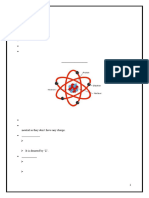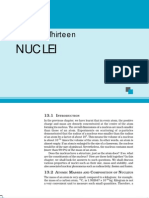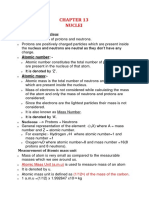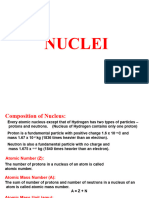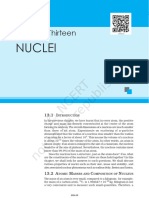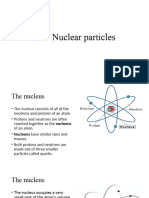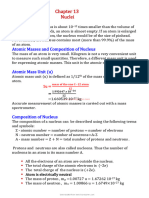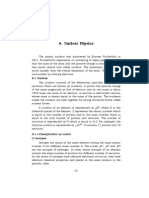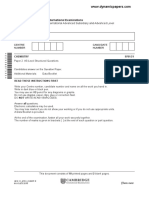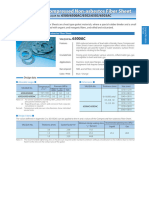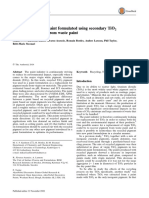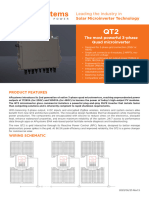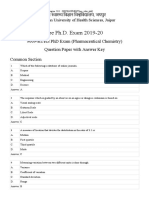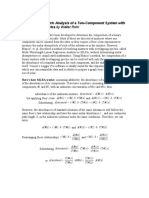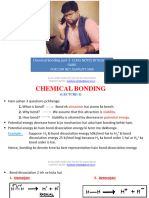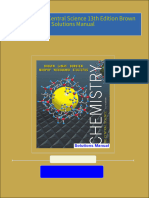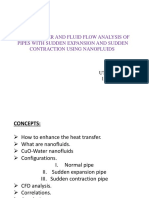0 ratings0% found this document useful (0 votes)
18 viewsModern Physics: Substructure of The Nucleus
Modern Physics: Substructure of The Nucleus
Uploaded by
Ma. Gienica Anonuevo1) The nucleus contains two main particles - protons and neutrons, collectively called nucleons.
2) Protons and neutrons have similar masses, with neutrons slightly more massive. Their masses are much greater than electrons.
3) Properties of a nucleus are determined by its number of protons and neutrons, represented by the symbols Z, N, and A, where A = N + Z.
Copyright:
© All Rights Reserved
Available Formats
Download as PPTX, PDF, TXT or read online from Scribd
Modern Physics: Substructure of The Nucleus
Modern Physics: Substructure of The Nucleus
Uploaded by
Ma. Gienica Anonuevo0 ratings0% found this document useful (0 votes)
18 views7 pages1) The nucleus contains two main particles - protons and neutrons, collectively called nucleons.
2) Protons and neutrons have similar masses, with neutrons slightly more massive. Their masses are much greater than electrons.
3) Properties of a nucleus are determined by its number of protons and neutrons, represented by the symbols Z, N, and A, where A = N + Z.
Original Title
ModPhys-PPT-Anonuevo
Copyright
© © All Rights Reserved
Available Formats
PPTX, PDF, TXT or read online from Scribd
Share this document
Did you find this document useful?
Is this content inappropriate?
1) The nucleus contains two main particles - protons and neutrons, collectively called nucleons.
2) Protons and neutrons have similar masses, with neutrons slightly more massive. Their masses are much greater than electrons.
3) Properties of a nucleus are determined by its number of protons and neutrons, represented by the symbols Z, N, and A, where A = N + Z.
Copyright:
© All Rights Reserved
Available Formats
Download as PPTX, PDF, TXT or read online from Scribd
Download as pptx, pdf, or txt
0 ratings0% found this document useful (0 votes)
18 views7 pagesModern Physics: Substructure of The Nucleus
Modern Physics: Substructure of The Nucleus
Uploaded by
Ma. Gienica Anonuevo1) The nucleus contains two main particles - protons and neutrons, collectively called nucleons.
2) Protons and neutrons have similar masses, with neutrons slightly more massive. Their masses are much greater than electrons.
3) Properties of a nucleus are determined by its number of protons and neutrons, represented by the symbols Z, N, and A, where A = N + Z.
Copyright:
© All Rights Reserved
Available Formats
Download as PPTX, PDF, TXT or read online from Scribd
Download as pptx, pdf, or txt
You are on page 1of 7
Modern Physics
Substructure of the Nucleus
Substructure of the Nucleus
• Two types of particles in the nuclei—the proton and the neutron, referred
to collectively as nucleons, the constituents of nuclei.
• The neutron is a neutral particle (q =0) that has nearly the same mass and
intrinsic spin as the proton compares the masses of protons, neutrons, and
electrons.
• How close the proton and neutron masses are, but the neutron is slightly
more massive once you look past the third digit. Both nucleons are much
more massive than an electron. In fact, mp = 1836 me and mn = 1839 me.
• Unified atomic mass unit (u), defined as 1 u = 1.660510 -27 kg
Substructure of the nucleus
• It is useful to note that 1 u of mass converted to energy produces 931.5 MeV, or 1 u = 931.5
MeV/c2
• All properties of a nucleus are determined by the number of protons and neutrons it has. A
specific combination of protons and neutrons is called a nuclide and is a unique nucleus.
The following notation is used to represent a particular nuclide: where the symbols , , ,
and are defined as follows: The number of protons in a nucleus is the atomic number , as
defined in Medical Applications of Nuclear Physics. X is the symbol for the element, such as
Ca for calcium. However, once is known, the element is known; hence, and are redundant.
• For example, Z=20 is always calcium, and calcium always has Z=20. N is the number of
neutrons in a nucleus. In the notation for a nuclide, the subscript N is usually omitted. The
symbol A is defined as the number of nucleons or the total number of protons and neutrons,
A = N + Z, where A is also called the mass number.
Substructure of the nucleus
• This name for A is logical; the mass of an atom is nearly equal to the mass of its nucleus,
since electrons have so little mass. The mass of the nucleus turns out to be nearly equal to
the sum of the masses of the protons and neutrons in it, which is proportional to A. It is
particularly convenient to express masses in units of u. Both protons and neutrons have
masses close to 1 u, and so the mass of an atom is close to A u.
• There is a scarce form of hydrogen found in nature called deuterium; its nucleus has one
proton and one neutron and, hence, twice the mass of common hydrogen. The symbol for
deuterium is, thus 2/1 H1, (sometimes is used, as for deuterated water D2O). An even
rarer—and radioactive—form of hydrogen is called tritium, since it has a single proton
and two neutrons, and it is written 3/1H2. These three varieties of hydrogen have nearly
identical chemistries, but the nuclei differ greatly in mass, stability, and other
characteristics. Nuclei (such as those of hydrogen) having the same Z and different N s are
defined to be isotopes of the same element.
Substructure of the nucleus
• There is some redundancy in the symbols A, X, Z, and N. If the
element X is known, then Z can be found in a periodic table and is
always the same for a given element. If both A and X are known, then
N can also be determined (first find Z ; then, N= A-Z ). Thus the
simpler notation for nuclides is AX which is sufficient and is most
commonly used
Substructure of the nucleus
• Nucleons can be separated by a large force, such as in a collision with
another nucleus, but resist strongly being pushed closer together. The
most compelling evidence that nucleons are closely packed in a
nucleus is that the radius of a nucleus, r , is found to be given
approximately by r= r0A3/1 where r0 = 1.2 fm and A is the mass
number of the nucleus.
Substructure of the nucleus
• Nucleons are held together by nuclear forces and resist both being
pulled apart and pushed inside one another. The volume of the nucleus is
the sum of the volumes of the nucleons in it, here shown in different
colors to represent protons and neutrons.
• What forces hold a nucleus together? The nucleus is very small and its
protons, being positive, exert tremendous repulsive forces on one
another. The answer is that two previously unknown forces hold the
nucleus together and make it into a tightly packed ball of nucleons.
These forces are called the weak and strong nuclear forces. Nuclear
forces are so short ranged that they fall to zero strength when nucleons
are separated by only a few fm.
You might also like
- Principles and Application Lithium Secondary BatteriesDocument7 pagesPrinciples and Application Lithium Secondary BatteriesGonzalo Almeida0% (1)
- Module Nuc - Phys I (Phys382) New1Document26 pagesModule Nuc - Phys I (Phys382) New1davididosa40No ratings yet
- Nuclei-Class 1-NotesDocument17 pagesNuclei-Class 1-Notesdimple joeNo ratings yet
- Nuclear Phy Chapter 2Document24 pagesNuclear Phy Chapter 2adayeada6No ratings yet
- 18BPH62C U3Document63 pages18BPH62C U3moneymaker1906vNo ratings yet
- Nuclei NotesDocument14 pagesNuclei Notess40088500No ratings yet
- Atomic Mass UnitDocument6 pagesAtomic Mass UnitVansh SinghaiNo ratings yet
- Nuclear Physics Class x1 NoteDocument14 pagesNuclear Physics Class x1 Noteduttamrit629No ratings yet
- 'NUCLEIDocument39 pages'NUCLEIRITIKANo ratings yet
- Chapter 13 PDFDocument29 pagesChapter 13 PDFSuresh Babu KarunakaranNo ratings yet
- 13 NucleiDocument13 pages13 Nucleivallabh.moapNo ratings yet
- NucleiDocument29 pagesNucleiVaibhav Singh100% (1)
- 9-Lecture 9Document29 pages9-Lecture 9george.1023077No ratings yet
- Nuclei: © Ncert Not To Be RepublishedDocument29 pagesNuclei: © Ncert Not To Be RepublishedMridul GuptaNo ratings yet
- NUCLEI NOTESDocument8 pagesNUCLEI NOTESbangladesh9451No ratings yet
- Phy 3Document22 pagesPhy 3sakshamsharma7257No ratings yet
- Nuclear Phy Lecture1Document11 pagesNuclear Phy Lecture1foyshall foraejeeNo ratings yet
- NucleiDocument8 pagesNucleiZahaan SajidNo ratings yet
- Nuclear PHYSICSDocument195 pagesNuclear PHYSICSAugustte StravinskaiteNo ratings yet
- 13-NUCLEIDocument36 pages13-NUCLEInidhiud777No ratings yet
- Chapter 3Document20 pagesChapter 3YasserMohammedNo ratings yet
- Chapitre 1 1Document15 pagesChapitre 1 1Ri HabNo ratings yet
- 14 - Nucleus 14.1 Nucleus - General InformationDocument12 pages14 - Nucleus 14.1 Nucleus - General InformationHrishabh GuptaNo ratings yet
- Nuclei OptimizeDocument33 pagesNuclei Optimizearpitsinghbaghel100No ratings yet
- Nuclei: Chapter ThirteenDocument17 pagesNuclei: Chapter ThirteenBhoomika VijayakumarNo ratings yet
- Leph 205Document29 pagesLeph 205Avnish BhattiNo ratings yet
- Illustration Aesthetic Physics Blank Paper A4 DocumentDocument30 pagesIllustration Aesthetic Physics Blank Paper A4 Documentdebanu2204No ratings yet
- Nuclear PhysicsDocument11 pagesNuclear Physicsvaigundh vaiNo ratings yet
- Nuclei NewDocument15 pagesNuclei NewB 06 Tenzin Stopden100% (1)
- Leph 205Document17 pagesLeph 205shreyamaheshr2007No ratings yet
- Nuclear Physics Grade XIDocument51 pagesNuclear Physics Grade XIlamichhaneunique42No ratings yet
- 2024-12-01-0.5093190526922166Document10 pages2024-12-01-0.5093190526922166nikhilsaini180001No ratings yet
- Nuclear Physics and Examples-2022Document14 pagesNuclear Physics and Examples-2022OSCARNo ratings yet
- NUCLEIDocument26 pagesNUCLEIshinnosukenoharahNo ratings yet
- Atoms and Nuclei2012-Notes UnlockedDocument29 pagesAtoms and Nuclei2012-Notes Unlockedapi-250079701No ratings yet
- nucleus chapterDocument13 pagesnucleus chapteradwaidh1174No ratings yet
- 14.1 Nuclear ParticlesDocument21 pages14.1 Nuclear ParticlesSamah MohamedNo ratings yet
- Atomic Nucleus and Nuclear EnergyDocument41 pagesAtomic Nucleus and Nuclear EnergyArundhati KulkarniNo ratings yet
- L-13 - Nuclei NotesDocument12 pagesL-13 - Nuclei Notespramiti.gNo ratings yet
- Chapter IvDocument15 pagesChapter Ivdedy krisnayanaNo ratings yet
- New Harmonize 1Document10 pagesNew Harmonize 1najeebmuhammedbello222No ratings yet
- 3rd Chapter (PHY-1203)Document48 pages3rd Chapter (PHY-1203)billmusa42No ratings yet
- Nuclear PhysicsDocument43 pagesNuclear PhysicsJitender MeenaNo ratings yet
- 4nuclear PhysicsDocument13 pages4nuclear PhysicsMuhammad Abdullah ArshadNo ratings yet
- Class 12 Nuclei- Part 1-1Document5 pagesClass 12 Nuclei- Part 1-1lakshmiktr15No ratings yet
- The Nuclear AtomDocument4 pagesThe Nuclear AtomMantiki QhobosheaneNo ratings yet
- 13. NUCLEI NOTESDocument8 pages13. NUCLEI NOTESmrdeadshot0987No ratings yet
- Note For EJUDocument18 pagesNote For EJUmr.draungnaingwinNo ratings yet
- Notes On Nuclear PhysicsDocument12 pagesNotes On Nuclear PhysicsBS PhysicsNo ratings yet
- Nuclei: - . - Types of Elements: Isotopes: IsobarsDocument12 pagesNuclei: - . - Types of Elements: Isotopes: IsobarsrgryjhgsdvrtNo ratings yet
- Nuclear PhysicsDocument20 pagesNuclear PhysicsShubh GuptaNo ratings yet
- Nuclei NewDocument9 pagesNuclei Newrosnarenil2007No ratings yet
- PHS A DSE B1 TH Lecture 1Document12 pagesPHS A DSE B1 TH Lecture 1inzy283No ratings yet
- Nuclei 2024-25Document12 pagesNuclei 2024-25Heba FathimaNo ratings yet
- Nuclei: Atomic Mass Unit (U)Document10 pagesNuclei: Atomic Mass Unit (U)Jatin PanjwaniNo ratings yet
- NucleusDocument14 pagesNucleusRaj AroraNo ratings yet
- Nuclear Physics: 8.1 NucleusDocument48 pagesNuclear Physics: 8.1 NucleusJanani PillaiNo ratings yet
- Concepts of Nuclear Medicine Volume I: Concepts of Nuclear Medicine, #1From EverandConcepts of Nuclear Medicine Volume I: Concepts of Nuclear Medicine, #1No ratings yet
- Your Journey To The Basics Of Quantum Realm Volume II: Your Journey to The Basics Of Quantum Realm, #2From EverandYour Journey To The Basics Of Quantum Realm Volume II: Your Journey to The Basics Of Quantum Realm, #2Rating: 5 out of 5 stars5/5 (1)
- Simplis MaDocument25 pagesSimplis Maevy VSNo ratings yet
- Key Chemical Enginnering ConceptsDocument10 pagesKey Chemical Enginnering ConceptsTowfiq AhmedNo ratings yet
- Ancamine 1934 UsDocument3 pagesAncamine 1934 UsNIKESH PRAKASHNo ratings yet
- Generation Transmission and Distribution Notes.Document88 pagesGeneration Transmission and Distribution Notes.Abhishek NirmalkarNo ratings yet
- X-Ray Diffraction BasicsDocument11 pagesX-Ray Diffraction BasicsHcene HcenNo ratings yet
- Jahn Teller Distortion - Effect - Theorem - Examples - AdichemistryDocument6 pagesJahn Teller Distortion - Effect - Theorem - Examples - AdichemistryAjit nayakNo ratings yet
- Cambridge International Advanced Subsidiary and Advanced LevelDocument12 pagesCambridge International Advanced Subsidiary and Advanced LevelThaarvena RetinaNo ratings yet
- Manzil JEE (2024) Electric Charges and Field: JEE Revision Practice SheetDocument8 pagesManzil JEE (2024) Electric Charges and Field: JEE Revision Practice SheetMr. ThomasNo ratings yet
- Bandstructure ExplanationDocument119 pagesBandstructure Explanation3femtoNo ratings yet
- Bariwal 2013Document21 pagesBariwal 2013Le Anh NhatNo ratings yet
- Gasket - 6500AC Data SheetDocument2 pagesGasket - 6500AC Data SheetAndrey AndrukhovichNo ratings yet
- Microbiology With Diseases by Taxonomy 4th Edition Bauman Test Bank 1Document538 pagesMicrobiology With Diseases by Taxonomy 4th Edition Bauman Test Bank 1ricardo100% (62)
- Practical Crystallography ManualDocument136 pagesPractical Crystallography Manualeyayuayalew287No ratings yet
- Unit 5Document69 pagesUnit 5NTGNo ratings yet
- Crystal StructureDocument52 pagesCrystal StructureTausif TausNo ratings yet
- Characterization of Paint Formulated Using SecondaDocument8 pagesCharacterization of Paint Formulated Using SecondasiaNo ratings yet
- API 571 Study Guide-Practice Questions For API 570 Exam - Boiler Water Condensate Corrosion (4.3.5)Document3 pagesAPI 571 Study Guide-Practice Questions For API 570 Exam - Boiler Water Condensate Corrosion (4.3.5)NIMANo ratings yet
- Chemical Bonding and Molecular StructureDocument78 pagesChemical Bonding and Molecular StructureDingetegna GodanaNo ratings yet
- Basics of HemodialysisDocument43 pagesBasics of HemodialysisDani Dany100% (1)
- APsystems Microinverter QT2 For North America Datasheet - Rev1.5 - 2023!06!25Document2 pagesAPsystems Microinverter QT2 For North America Datasheet - Rev1.5 - 2023!06!25Firoz KhanNo ratings yet
- Pre Ph.D. Exam 2019-20: 9009-Ruhs PHD Exam (Pharmaceutical Chemistry) Question Paper With Answer Key Common SectionDocument20 pagesPre Ph.D. Exam 2019-20: 9009-Ruhs PHD Exam (Pharmaceutical Chemistry) Question Paper With Answer Key Common SectionFarhadz Sailama Barahama100% (1)
- Porosity LogDocument15 pagesPorosity Logmts1234No ratings yet
- Spectrophotometric Analysis of A Two-Component SystemDocument5 pagesSpectrophotometric Analysis of A Two-Component Systemiabureid7460No ratings yet
- Chemical Bonding Part - 1 by Kuldeep SirDocument208 pagesChemical Bonding Part - 1 by Kuldeep SirMasoodNo ratings yet
- Chemistry The Central Science 13th Edition Brown Solutions Manual all chapter instant downloadDocument50 pagesChemistry The Central Science 13th Edition Brown Solutions Manual all chapter instant downloadmutonikolyu100% (6)
- Introduction To Pinch TechnologyDocument46 pagesIntroduction To Pinch TechnologyM Scott GreenNo ratings yet
- Ha Verkamp 2008Document8 pagesHa Verkamp 2008a d e eNo ratings yet
- Study On Nanofluids FlowDocument33 pagesStudy On Nanofluids Flowuttej BadeNo ratings yet
- Humic Acid Recovery MethodDocument2 pagesHumic Acid Recovery MethodSubrata Parai100% (1)





